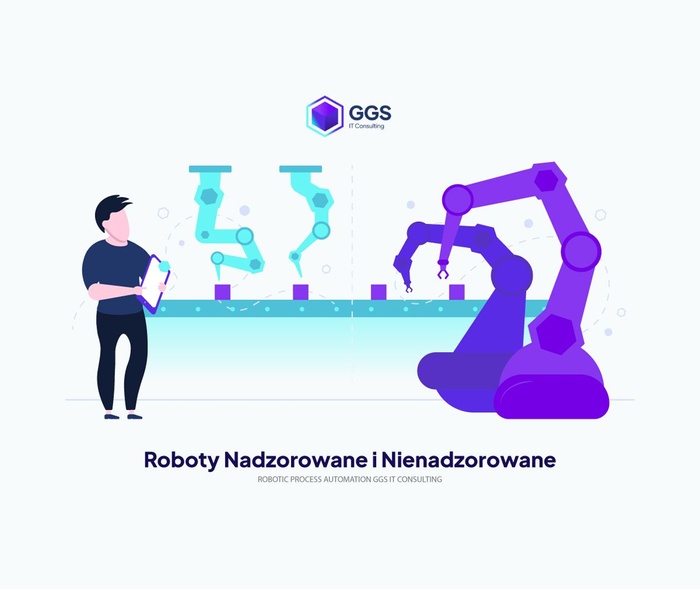Business Process AutomationLearn more
Attended and Unattended robots – what’s the difference?

When talking about Robotic Process Automation, we will need to decide on a particular type of robot at some point. One way to classify robots is to divide them into attended and unattended ones. In this article we write about the differences between them.
1. ROBOTIC PROCESS AUTOMATION (RPA) – WHAT IS IT AND HOW DOES IT WORK?
RPA is the robot-based automation of processes previously carried out by employees. Appropriately programmed robots interacting with computers carry out repetitive, rule-based tasks as well as perform calculations, and make set decisions. RPA is used in a wide range of industries, from IT, finance and commerce to telecommunications, office administration, logistics, manufacturing and tourism. The possibilities for RPA are endless, with businesses using robots to automate both front-office and back-office tasks. Robots help complete records and documents, and can be used for sending automatic notifications, filling out agendas, data transfers between systems, creating documents, reporting, controlling or ensuring data compliance. The RPA market is already worth more than $1 billion and research firm Forrester estimates it will reach almost $3 billion by 2021. This is because the use of robots is key in streamlining business operations, enabling faster and more precise work and reducing company costs. Depending on the needs of the company and the type of activities the robots have to perform, a distinction is made between attended (Bot Attended), unattended (Bot Unattended) and hybrid robots.
2. ATTENDED BOTS
Attended Bots, or supervised robots, are used to optimise processes and costs for tasks where full automation is not possible. They need to be triggered by a human in order to perform a task. They then carry out specific activities on their own, while the employee can make strategic, creative, well-thought-out decisions. Attended robots are used primarily in front-office processes, where they interact with a human operator in a way that resembles working with an assistant that receives specific instructions and acts on them. As attended robots need to interact with one specific person, they are not used for large-volume work in a company, but for dedicated purposes
EXAMPLES OF USES OF ATTENDED BOTS
HR departments often use business-oriented social networks when recruiting new employees. After finding a group of candidates who meet the criteria set by the employer, they send messages to potential employees. These HR tasks can be successfully carried out robots programmed to send personalised messages to make contact wit the candidates pre-selected by the HR department.
How many hours have you worked? – this question posed to employees is usually answered by the company’s internal time-keeping system. But what if the same question is posed to employees in the service industries by the clients we are currently working for? What if you are working on projects for several clients at the same time and each client requires you to record hours worked for them in different systems? This is when the RPA and attended bot step in, recording the employee’s working hours in one system and then activates the robot, which automatically copies the working hours to another system.
Working for a client, robots help save employee time by not only copying working hours between systems, but can also create invoices for individual parts of a completed project based on completed tasks and reports. This saves time for the employee, who does not have to prepare the invoice himself, check the data and the currency (in which the project is billed), because the robot enters the necessary information and converts the currencies at the rate of the National Bank of Poland on a given day.
Onboarding bot - a tool that serves all employees in a company, which is designed to send messages about newly hired employees in the company in an instant-messenger format (Slack). After listing all the necessary information about the employee, the activated robot sends it to the other team members.

3. UNATTENDED BOT
Unsupervised robots, also known as unattended bots, operate independently, without human intervention, and their use means that the process is fully automated. Supervised robotic tasks are initiated automatically and work is carried out continuously 24 hours a day, seven days a week, 365 days a year.
Unattended bots are most often incorporated into back-office processes to carry out repetitive, predictable, time-consuming actions that follow specific patterns and steps.
EXAMPLES OF APPLICATION OF UNSUPERVISED ROBOTS
An onboarding bot is a tool that in the first phase is run by a human (link to: “Examples of application of supervised robots” – “onboarding bot”), and in a later stage allows key messages to be sent automatically to the team. Using the integrated calendar system for meetings/events/conferences, the configured robot sends automatic messages about meeting dates, links, documents, information about the necessary tools for preparation. This allows employees to be fully productive without having to focus on constantly checking their calendars, analysing what needs to be prepared or what meeting they forgot about.
Sometimes it happens that an employee forgets to enter data - working hours, holidays, equipment information - into the system. A suitably configured robot continuously checks in the system whether all the necessary data are entered. Once running, it works regularly, continuously analysing the information contained in any platform used by the company. If it detects missing information, it automatically sends a message on the instant messenger.
Banking and commerce are industries that use RPA tools very frequently. They use robots to automatically retrieve data from one system, check it against certain criteria and enter it into another database, and send notifications of the success or failure of a particular action. Robots are used, for example, to analyse credit limit amounts, creditworthiness or to determine discounts.
4. SUPERVISED AND UNSUPERVISED ROBOTS. 10 DIFFERENCES
Supervised robot
- acts as an assistant for the employee (software assistant)
- used for simple, routine, tedious office activities
- usually run on the employee's computer
- activated and controlled by a specific employee
- works during the employee's working hours
- its construction is simple
- limited possibilities for expansion of operation and extension
- the cost of a licence to run a supervised robot is lower than the cost of a licence for an unsupervised robot
- its task focus is defined in the short term (e.g. to carry out specific actions)
- used in front-office departments and tasks
Unsupervised robot
- works alone
- carries out various, often complex, business process tasks
- runs on a server, in the cloud
- does not require the presence of an employee for commissioning
- its operation is programmed, it works automatically
- increases the efficiency of the business process
- can work 24 hours a day, 7 days a week, 365 days a year
- the cost of a licence to run an unsupervised robot is several times higher than a supervised robot
- implementation requires reorganisation of work and business processes
- used in back-office departments and tasks
